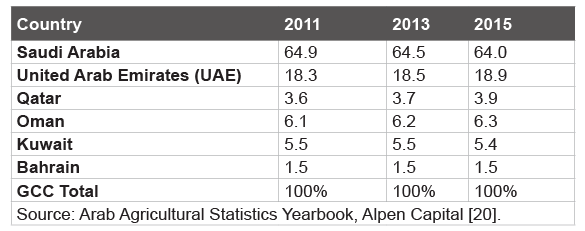
Table 1: Share of food consumption for each country within GCC (%).

Aly F. El Sheikha*
Assistant Professor, Department of Biology, Faculty of Science, Al-Baha University, Al-Baha, Saudi Arabia*Corresponding author: Aly EL Sheikha, Assistant Professor, Department of Biology, Faculty of Science, Al-Baha University, P.O. Box 1988, Al-Baha, Saudi Arabia, Tel: +966 5 46 28 33 15; Fax: +966 1 77 27 13 81; E-mail: elsheikha_aly@yahoo.com
Food borne outbreaks have become a major challenge in food safety, in general, and for safer food supply chains, in particular. In Saudi Arabia, food poisoning is becoming a very important health problem, Salmonella species is the most important pathogen, but due to the extensive effort carried by the health authorities to prevent or eradicate communicable diseases, new pathogens are now emerging such as Escherichia coli and Norwalk like viruses. The implementation of food safety programs in the food industry and improvements in hygiene education for people working with foods have effectively decreased or eliminated some food borne diseases from Saudi Arabia. Common concerns are the diversity of microorganisms and the ability of food borne pathogens adapt to a new environment as these are likely to increase the degree of difficulty for surveillance and prevention of food borne diseases. This review paper highlights the present situation of food safety in Saudi Arabia and what is the key of magic to avoid all the challenges facing food safety to reach a healthy food finally.
Food safety; Food borne diseases; Risks and prevention; Traceability; Saudi Arabia
Food is the primary requirement for sustainability and livelihood but it is also a vehicle and a medium for transmitting hazards and causing disease and death. The term “safe food” represents different ideals to different audiences. Views and descriptions of safe food held by consumers, academicians, industry and special interest groups differ and are diverse. Thus almost any single definition of food safety will be overly simplistic [1].
For consumers, the descriptions of safe food are generally quite practical and simple. Consumers of course come in all sorts; they differ in age, sex, culture, life experience, health, knowledge, nutritional needs, family status, purchasing power, occupation, education and access to the media. Thus their ideas of safe food will vary. For example, some may regard safe food as food that does not make a person sick. Others may describe safe food as food that is within its shelf life and has been stored or distributed at the proper temperature. Some consumers may define safe food as food that is not “contaminated” [2].
The colloquium on food safety for the American Academy of Microbiology has described safe food as the following: Safe food, if properly handled at all steps of production, processing, distribution, from retail and food service business through consumption, is reliably unlikely to cause illness or injury [3]. The food industry defines food safety by its specification for raw materials and finished products. These specifications define the acceptable limits for chemical hazards such as hormones and pesticides, physical hazards such as metal fragments, and microbiological hazards such as Salmonella sp. and Listeria sp. Food safety of course goes beyond food production and sale to the consumers themselves and their own handling and consumption of food.
Recently, World Health Organization (WHO) defined food safety as a term that generally refers to ways and approaches to ensure that the production, preservation, distribution and consumption of food happen in a safe manner. Food borne diseases are a growing public health problem in both developed and developing countries today. Consumption of contaminated food could increase the risk of consumer acquiring an illness, caused a food borne illness or disease. Every year, food borne and waterborne diarrheal diseases kill about 2.2 million people, including 1.9 million children [4]. The health care cost of food borne diseases has become a heavy economic burden for countries.
The Arab Gulf countries, namely, Bahrain, Kuwait, Oman, Qatar, Saudi Arabia, and United Arab Emirates have undergone a rapid change in their socio-economic situation, food consumption patterns, and lifestyle and health status during the past four decades. This was mainly caused by the sharp increase in income due to accumulated oil revenues. Communicable diseases have almost diminished and diet-related chronic diseases have become the main health problems. However, under nutrition and micronutrient deficiencies still exist, especially among vulnerable groups [5]. Studies in Saudi Arabia revealed that 28% to 80% of adults had vitamin D deficiency [6]. Low sunlight exposure, low intake of dietary vitamin D and calcium, and short duration of breastfeeding during the first six months are the main risk factors for occurrence of this problem [7]. In Saudi Arabia, for example, it was found that 28% of diabetes were unaware of their condition [8].
Kingdom of Saudi Arabia (KSA) is the largest Arab state in Western Asia by land area (approximately 2,150,000 km2 ), constituting the bulk of the Arabian Peninsula, and the second-largest geographically in the Arab world after Algeria. The kingdom is categorized as a high income economy with a high Human Development Index (HDI) [9], and is the only Arab country to be part of the G-20 major economies [10,11]. The Kingdom has a total population of 28.7 million (Saudi population represents 70% of the Cooperation Council for the Arab States of the Gulf “GCC”), of which 20 million are Saudi nationals and 8 million foreigners [12-14]. Its Gross Domestic Product (GDP) per capita is estimated at $51,779 in purchasing power parity (PPP). It is ranked eleventh in the world in terms of nominal GDP/capita [15].
The people of Saudi Arabia are descended from tribes of nomadic sheep and goat herders and maintain many of the traditions of their past. Traditional foods like dates, fatir (flat bread), arikah (bread from the southwestern part of the country), and hawayij (a spice blend) are still eaten by Saudis today, although most Saudis have settled in towns and cities and no longer follow the nomadic lifestyle. Saudi Arabia is also home to Mecca, the origin and spiritual center of Islam. The culture, as well as the laws of Saudi Arabia, is founded on Islamic principles, including the dietary restrictions against eating pork or drinking alcohol [16,17].
Agricultural growth in Saudi Arabia is limited by scarce water resources. Recent development plans have sought to grow crops that need less water. In value terms, Saudi Arabia is the world’s 19th largest agri-food importer. On average 80% of Saudi Arabia’s food needs are imported. Limited agricultural production will lead to continuing and increasing imports in the future. The agriculture sector represents only 6% of Saudi Arabia’s GDP. Top Saudi agri-food imports include barley, sheep, rice, chicken and wheat. Top suppliers are Brazil, India, Ukraine Australia and Canada. In 2012 Canada’s share of the Kingdom’s imports of agri-food products amounted to over $260 million, Grains and cereals, mainly wheat, valued at over $195 million, accounted for the majority of Canadian agri-food exports to Saudi Arabia. Other exports include processed food, frozen vegetables (mainly fries), cheeses, honey, pasta, oil seeds, boneless beef, pulses and ice-cream [18].
Local food producers, manufacturers, retailers & service providers are enjoying a boom in Saudi. Global firms can benefit from this outstanding potential. Saudi Arabia is a secure country with a low cost exporting base, which is experiencing a significant rise in consumption. Tables 1-3 illustrated Saudi statistics in food consumption and imports at present and which expect in the future. As following some of key facts concerning economic issues of food in Saudi Arabia [19]:
- Saudi food consumption is 3130 calories per capita per day.
- Saudi Arabia’s food sector witnessing annual growth of 18.5%.
- Saudi Arabia imports $14.2 billion/annually in food and drink.
- Due to a rising population and economic growth, consumption will
grow 55.3% in 4 years to reach $70 billion/annually.
Food borne diseases, an increasing public health problem, are responsible for considerable morbidity and mortality globally. Various pathogens (bacteria, viruses, and parasites) and toxins (industrial chemical and bio-toxins) are known to cause more than 250 food borne diseases of which the majority of deaths are caused by diarrheal diseases worldwide [23,24].

Table 1: Share of food consumption for each country within GCC (%).
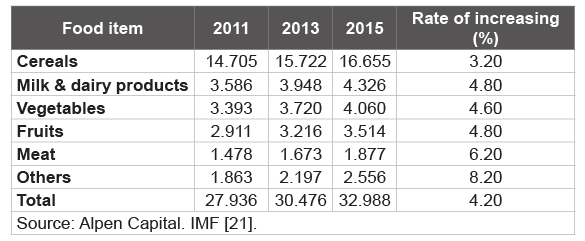
Table 2: Consumption of main food items in Saudi Arabia (‘000 tons).
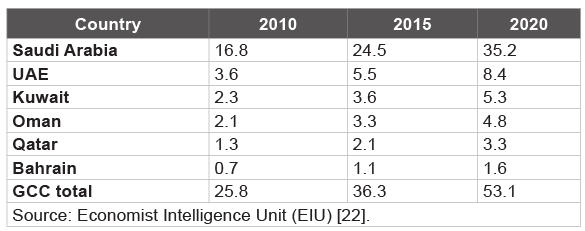
Table 3: Food imports estimates of Saudi Arabia comparing with other GCC countries.
Imported food makes up about 70% of the food consumed in the Kingdom of Saudi Arabia. If we take into account the number of people living on the Saudi soil, about 30 million Saudis and non-Saudis, we can imagine the huge quantities of food going through the borders. Therefore, the issue of food safety is at the forefront of the regulatory responsibilities and redline, which must not be compromised. Thus, ensuring the safety of these vast amounts of imported food and their compliance with the required standards and regulations creates a great challenge for the control bodies [25].
With problems in every part of the region’s supply chain infrastructure, Middle Eastern states will face losses, spoilage and delays. Because of the lack of quality logistics, a country like Saudi Arabia doesn’t have mechanized grain terminals. As a result of that, Saudi Arabia will have a 7-8% loss of grains [26].
In Saudi Arabia, brucellosis, salmonellosis, typhoid and paratyphoid fever, shigellosis, amoebic dysentery, and hepatitis A are diseases that must be reported to the Ministry of Health (MOH). Therefore, the yearly statistical records of the MOH [27,28] were used to obtain data regarding the incidence of these diseases. Food poisoning cases in Saudi Arabia were registered as ill-defined in patients who were admitted to hospital emergency rooms. For other non-notifiable food borne diseases, a literature search (for the period from 2003 to 2013) was performed online in 7 databases for outbreak-related data.
Food prepared and consumed at home is considered a source for a large proportion of food borne diseases in developed and developing countries where consumers do not follow proper food handling practices [29,30].
Few reports focused on bacterial food poisoning, showed that staphylococci are implicated in 41% of bacterial food poisoning cases in Saudi Arabia [31]. Despite all these reports, very little is known about the prevalence of drug resistant staphylococci in foodstuffs and the environment in Saudi Arabia. Table 4 illustrated prevalence of staphylococci in food in Saudi Arabia. A recent study from Saudi Arabia found that bacterial isolates from fresh vegetables exhibited higher resistance rates than our study to ampicillin, cephalothin, trimethoprimesulfamethoxazole, aminoglycosides, tetracycline, fluoroquinolones, amoxycillin-clavulanic acid, and chloramphenicol [32]. Also, a similar study showed that coliforms with multiple resistances to four or more antimicrobial agents were contaminating raw vegetables, and they were also associated with the presence of plasmids of varied sizes (Table 4).
Food may be mishandled during storage, during preparation, or before its consumption at home, thus leading to cross-contamination and microbial growth in food. These situations can be controlled if consumers have the necessary knowledge for prevention. As the safety of homecooked food is uncontrollable, by regulating authorities, education of consumers regarding proper food handling and cooking practices is a feasible way to engage them in any national food safety initiative [34].
In KSA, a set of general and specific measures can be taken to reduce the food poisoning outbreaks in future. The general measures are mostly targeted the food handlers who may act as source for infections such as Salmonella typhi, Pseudomonas aeruginosa, Staphylococcus aureus, and E.coli, or act as the mean to propagate the causative agents by poor food handling practices. Food handlers should be asked to thoroughly wash their hands after defecation; wash the hands frequently before, during and after handling the food; use clean gloves or utensils while handling food; maintain a sanitary kitchen; thoroughly cook the meats; avoid cross contamination between raw and cooked food; protect prepared foods against rodent and insect contamination; reduce time between food handling and service; maintain proper temperature of cooked food [30].
Saudi Arabia is one of countries have been able to comply with Codex Alimentarius and other standards recognized by the World Trade Organization, such as the Sanitary and Phytosanitary Agreement and Technical Barriers to Trade, continue to create obstacles to market expansion of Member States (Table 5). Saudi Arabia has adopted a strongly worded resolution that recognizes food safety as an essential public health function. The development of an interdisciplinary approach with direct interaction between monitoring, surveillance and risk analysis systems could be a potential basis for improved food borne disease prevention [2].
The Saudi Food and Drug Authority (SFDA) was established under the Council of Ministers resolution no (1) dated January 1, 2003, as an independent body that directly reports to the Prime Minister. SFDA is responsible to regulate, oversee, and control food, drug, medical devices, as well as set mandatory standard specifications thereof, whether they are imported or locally manufactured. The control and/or testing activities can be conducted at the SFDA or any other agency’s laboratories. Moreover, the SFDA is in charge of consumers’ awareness on all matters related to food, drug and medical devices and associated other products and supplies (Table 5) [35].
The burden of food borne diseases in Saudi Arabia is currently unknown. One of the key reasons is that microbial contamination is hard to predict and track back to its origin. For that the need arise to apply reliable system for tracing the origin of foodstuffs and the microorganisms contaminated the foodstuffs but how? [40,41].
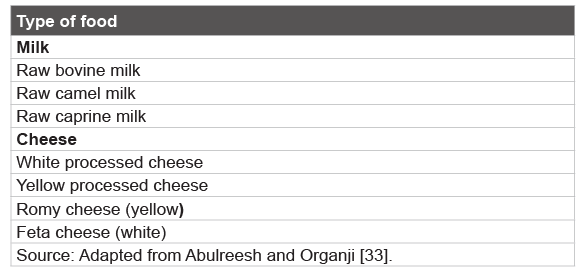
Table 4: Prevalence of staphylococci in food in Saudi Arabia.
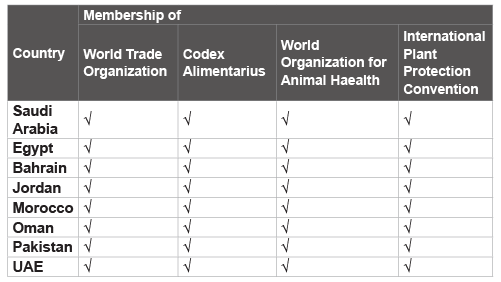
Table 5: Some countries had complied the standards of the organizations concerned with food safety [36-39].
Recently, tracking and tracing systems have become the most important methods used to ensure food safety, whereas food safety is an intrinsic part of food quality. A reliable traceability system means that a tool can allow a food company to track and trace any foodstuff which does not meet consumer expectations or the applicable regulations in an importing country. The main objective of a traceability system is to tell a product’s story, i.e., identify a unique product batch and the raw materials used in its production and follow that batch through its production and distribution all the way to the retailer. Today, tracking and traceability software tools are of major interest to the retail business (as a business to business communication tool). Tracking and traceability systems can be incorporated into information systems where consumers can receive information on any product. Traceability systems enable efficient product recall and allow fewer products to be recalled. This can bring important cost savings, where the aim is to provide consumers with nutritious and healthy products which are produced in a cost-efficient way [42,43].
Download Provisional PDF Here
Aritcle Type: Research Article
Citation: El Sheikha AF (2015) Food Safety Issues in Saudi Arabia. Nutr Food Technol 1(1): doi http:// dx.doi.org/10.16966/2470-6086.103
Copyright:© 2015 El Sheikha AF. This is an open-access article distributed under the terms of the Creative Commons Attribution License, which permits unrestricted use, distribution, and reproduction in any medium, provided the original author and source are credited.
Publication history:
All Sci Forschen Journals are Open Access